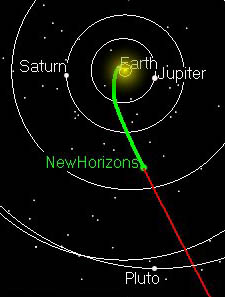Those of you with a soft spot for Pluto probably know that February was a big month for this far-flung world.
First came the unveiling, on February 4th, of a new surface map painstakingly constructed from Hubble Space Telescope images. Then, on the 18th, we celebrated the 80th anniversary of Pluto's discovery by Clyde Tombaugh at Lowell Observatory.

On March 1st, New Horizons was about 10 million miles closer to Pluto than it was to the Sun. (The green arc shows the craft's trajectory since its 2006 launch; red indicates its future path.) Click on the image for a larger view.
NASA / JHU-APL / Satellite Tool Kit
To these you can add one more event of note: on February 25th, the New Horizons spacecraft reached the point in its trajectory that places it closer to Pluto than it is to the Sun. As the mission's website touts, the craft's approach to Pluto has begun.
New Horizons has been coasting ever since its launch on January 19, 2006. So it's taken just four years to reach this halfway point. But the Sun's gravity has gradually slowed the craft, enough so that it will require another 5½ years to reach the outermost planet second-largest dwarf planet.
No matter how you slice it, the trip has been a long and basically boring one for both New Horizons and its science team. Like a long overnight flight from Tokyo to New York, there hasn't been much to look at since a dash past Jupiter for a gravity boost and some target practice exactly three years ago today (another February date of note). So New Horizons has been in electronic hibernation since last August; it'll be roused for a checkup in a few months.
You can follow the spacecraft's progress numerous ways, but I recommend reading the occasional musings of Alan Stern, the mission's principal investigator.
(Watch Stern and others defend Pluto's planetary status this week on "The Pluto Files," a PBS special hosted by Neil deGrasse Tyson.)
 9
9
Comments
Doctroid
March 1, 2010 at 8:49 am
"First-known dwarf planet"? Ceres was discovered in 1801.
You must be logged in to post a comment.
Phil
March 1, 2010 at 9:45 am
Is Ceres now considered a "dwarf planet", or is it still a "minor planet/asteroid"?
You must be logged in to post a comment.
[email protected]
March 1, 2010 at 10:00 am
This shows the problem with fiddling around with definitions. When Pluto was considered a planet, everyone understood the difference between it and Ceres. Now? I suppose the astronomers who objected to "planet" status for Pluto need to play around with the definitions further to inform us 'poor uneducated masses' what the difference between a "dwarf planet" and an "asteroid" is.
How long until we have arguments between "asteroids" large enough to be gravitationally shaped into spheres and "asteroids" that are too small to be gravitationally shaped into spheres?
You must be logged in to post a comment.
Kelly Beatty
March 2, 2010 at 8:44 pm
Doctroid and Phil...
thanks for picking that up -- now fixed.
You must be logged in to post a comment.
Laurel Kornfeld
March 2, 2010 at 9:58 pm
Pluto may no longer be the solar system's outermost planet, but it is still a planet, in spite of the IAU's nonsensical decree that dwarf planets are not planets at all. Dwarf planets are a third subclass of planets in addition to terrestrials and jovians. They are still planets because they are large enough to be rounded by their own gravity, but of the dwarf subcategory because they are not large enough to gravitationally dominate their orbits.
You must be logged in to post a comment.
Brian
March 3, 2010 at 7:21 am
Why is redefining the term planet a "nonsensical decree?" I was under the impression that one of the main points of science is to continue to explore, understand and uncover the mysteries of the universe. Theories and definitions get revised all the time. Think how silly, for example, it would be to keep thinking the heavens were a fixed celestial sphere simply because we were taught that fact in school (in 1600). We cannot hold onto the past as if it were a celestial teddy bear that we keep for comfort.
You must be logged in to post a comment.
Fred Gnerlich
March 3, 2010 at 10:46 am
Most people know what Pluto is - a celestial object in our solar system. As we have discovered, there are more Pluto-like objects in our solar system and likely in our galaxy. What's the point of all the debate? Like Shakespeare said "A rose by any other name would smell as sweet".
You must be logged in to post a comment.
AggieSquared
March 5, 2010 at 12:08 pm
According to the IAU, the definition of a planet is "a body that orbits the Sun, is large enough for its own gravity to make it round, and has "cleared its neighbourhood" of smaller objects." Earth fits the first two criteria, but hasn't exactly cleared it's neighbourhood of smaller objects - i.e. the moon. Hmmmm.
You must be logged in to post a comment.
Robert Sheaffer
March 6, 2010 at 3:43 pm
Actually, Pluto's recent change in status increases the significance of Tombaugh's discovery of it in 1930. In stead of discovering 'another planet,' Tombaugh discovered the very first example of a type of object that was completely unknown before:a Trans-Neptunian object, one of many icy worlds that orbit the sun out beyond Neptune.
You must be logged in to post a comment.
You must be logged in to post a comment.